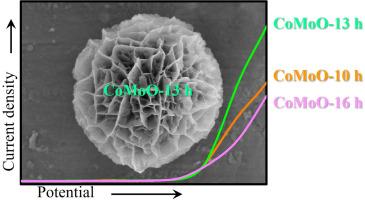Morphology-activity relationship study of CoMoO4 for electrocatalytic water oxidation in neutral medium
IF 5.7
3区 材料科学
Q2 MATERIALS SCIENCE, MULTIDISCIPLINARY
引用次数: 0
Abstract
To further explore the morphology-activity relationship between the morphology of CoMoO4 and its electrocatalytic oxygen evolution activity, we synthesized a series of CoMoO-X samples (where X represents the reaction time, specifically 10, 13, and 16 h) by precisely controlling the synthesis duration. The study systematically investigates the relationship between the morphological features of cobalt-based electrocatalysts and their catalytic performance, using structural characterization and electrochemical testing techniques. Our results demonstrate that these CoMoO-X samples possess distinct morphological features and electrocatalytic oxygen evolution performance. Notably, the sample synthesized for 13 h (CoMoO-13 h) exhibits superior electrocatalytic oxygen evolution performance under neutral conditions. Specifically, it achieves a current density of 10 mA cm-2 at an overpotential of 400 mV, displays a Tafel slope of 403 mV dec‑1, and maintains high stability for over 25 h at a voltage of 400 mV.

CoMoO4在中性介质电催化水氧化中的形态-活性关系研究
为了进一步探索CoMoO4的形貌与其电催化析氧活性之间的形态-活性关系,我们通过精确控制合成时间,合成了一系列CoMoO-X样品(其中X代表反应时间,分别为10、13和16 h)。本研究采用结构表征和电化学测试技术,系统地研究了钴基电催化剂的形态特征与其催化性能之间的关系。我们的研究结果表明,这些CoMoO-X样品具有明显的形态特征和电催化析氧性能。值得注意的是,合成13h的样品(comoo - 13h)在中性条件下表现出优异的电催化析氧性能。具体来说,它在400mv过电位下实现了10 mA cm-2的电流密度,显示了403 mV dec - 1的塔菲尔斜率,并在400mv电压下保持了超过25小时的高稳定性。
本文章由计算机程序翻译,如有差异,请以英文原文为准。
求助全文
约1分钟内获得全文
求助全文
来源期刊

Materials Research Bulletin
工程技术-材料科学:综合
CiteScore
9.80
自引率
5.60%
发文量
372
审稿时长
42 days
期刊介绍:
Materials Research Bulletin is an international journal reporting high-impact research on processing-structure-property relationships in functional materials and nanomaterials with interesting electronic, magnetic, optical, thermal, mechanical or catalytic properties. Papers purely on thermodynamics or theoretical calculations (e.g., density functional theory) do not fall within the scope of the journal unless they also demonstrate a clear link to physical properties. Topics covered include functional materials (e.g., dielectrics, pyroelectrics, piezoelectrics, ferroelectrics, relaxors, thermoelectrics, etc.); electrochemistry and solid-state ionics (e.g., photovoltaics, batteries, sensors, and fuel cells); nanomaterials, graphene, and nanocomposites; luminescence and photocatalysis; crystal-structure and defect-structure analysis; novel electronics; non-crystalline solids; flexible electronics; protein-material interactions; and polymeric ion-exchange membranes.
 求助内容:
求助内容: 应助结果提醒方式:
应助结果提醒方式:


